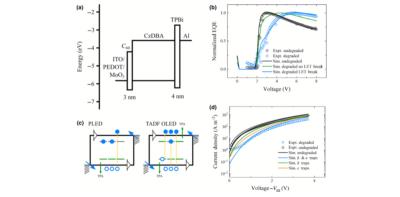Researchers from Germany's Max Planck Institute, led by Prof. Paul W.M. Blom, are looking into single-layer OLED devices (in which a single emitting layer is sandwiched between two electrodes), with an aim to match their efficiencies to those of common multilayer OLED stacks, like the ones used in commercial OLED displays.
Current OLED architectures utilize multilayer stacks of materials, in order to increase the performance and lifetime of OLED devices. But according to the latest findings by Prof. Blom, equal efficiencies can indeed be met with single-layer TADF OLED emitters - and there's no fundamental reason or major benefits that arise from multilayer OLEDs.
Single-layer devices have many advantages - first of all they utilize much less materials, and are much simpler to produce. This is especially suitable for inkjet printing processes, where usually the interaction between printed layers is a major challenge. Another advantage of single-layer devices is that the interpretation of the device physics and degradation is more straightforward as compared to complicated multilayer stacks, and thus advances in material design and device performance could be faster.
The researchers have studied the degradation of single-layer OLEDs based on a specific TADF emitter (9,10-bis[4-(9H-carbazol-9-yl)-2,6-dimethylphenyl]-9,10-diboraanthracene). After quantitatively describing the current-voltage (J-V) and efficiency curves after electrical driving, a numerical model was used to reproduce the voltage increase and light decrease during degradation. The researchers demonstrated that the fundamental mechanism behind OLED degradation is electron- and hole-trap formation due to triplet-polaron annihilation, the same as that reported for polymer light-emitting diodes (P-LEDs). Other mechanisms, such as triplet-triplet annihilation and singlet-triplet annihilation, do not match experimental data. Understanding of the degradation mechanism allowed the researchers to predict how a broader emission zone in a thicker single-layer TADF OLED affects its lifetime, resulting in an improved stability with a T80 lifetime of 1050 hours at an initial luminance of 1000 cd m−2.
Q: Prof. Blom - this is a very exciting claim you have. Do you think that potentially commercial OLEDs could be based on a single-layer architecture in the future?
Yes, as mentioned it has large cost advantages in terms of materials and ease of production.
Q: Is your conclusion applicable to TADF, P-LED and soluble OLEDs only? or is that also true for evaporated (SM) emitters?
To reach high efficiencies you need to harvest triplets using for example TADF. The basic physics for either soluble or evaporated OLEDs is the same, so fundamentally it is applicable to both.
Q: Why do you think the industry has chosen to adopt a multi-layer architecture while not pursuing single-layer ones?
Based on the low efficiencies of first generation PLEDs, over time it has been generally accepted that a multi-layer is necessary to get all processes in the OLED right, like injection, charge balance and recombination. The probability that one could manage all this in a single layer is considered highly unlikely. This notion then would also exclude the realization of a highly efficient printed OLED, since due to stack integrity it is very hard to coat 5-6 thin layers on top of each other. The fact that we now show that also single-layer devices can be efficient might stimulate industry to look (again) into this.
Q: What are your next steps in this research? Are there any thoughts about commercialization?
Next step will be to further improve stability, after that we will see.
Thank you Paul, this is very interesting research and we hope to hear from you soon with the next step results!
Comments
Information like this is relevant and on target - it's why I've considered OLED-info my primary source for all of the current OLED centric news ...since 2008.




I wrote about this nearly a decade ago as a lighting industry reporter...
It's unlikely that Organic light emitting products would not move past or beyond architecture of OLEDs circa 2012.
It's inevitable the layer count ( & BOM totals) would eventually drop,as I read this interview I felt it was validation of multiple years talking up OLEPs / Organic light emitting products.